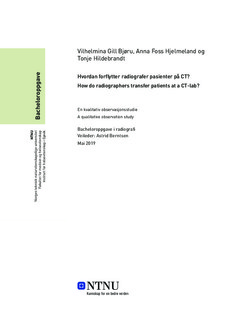| dc.contributor.advisor | Berntsen, Astrid | |
| dc.contributor.author | Bjøru, Vilhelmina Gill | |
| dc.contributor.author | Hjelmeland, Anna Foss | |
| dc.contributor.author | Hildebrandt, Tonje | |
| dc.date.accessioned | 2019-09-06T14:04:41Z | |
| dc.date.available | 2019-09-06T14:04:41Z | |
| dc.date.issued | 2019 | |
| dc.identifier.uri | http://hdl.handle.net/11250/2613380 | |
| dc.description.abstract | Hensikt
Formålet med denne oppgaven er å undersøke hva som er typisk for forflytning av pasient gjort av
en radiograf på CT-lab. Ved å finne ut hva som er karakteristisk ved forflytningen kan det øke
bevisstheten på god forflytning i utdanningen og arbeidslivet.
Metode
Metoden som er valgt for denne oppgaven er en kvalitativ, deltagende og strukturert
observasjonsstudie med supplerende semi-strukturerte intervjuer. Denne metoden ble valgt for å
kunne selv undersøke hvordan selve forflytningsprosessen foregår. Observasjonen foregikk på en
CT-lab på et sykehus i Sykehuset Innlandet. Utvalget for observasjonen er alle radiografer ved
aktuelt sykehus som var på CT-lab dagene med observasjon, og som var involvert i forflytningene.
Resultat
Det er varierende resultater på hvordan radiografene utfører forflytning i forhold til teori og
retningslinjer. Ut ifra analysene fra observasjon og intervju ble følgende kategorier valgt ut;
kommunikasjon, radiografenes arbeidsstilling, opplæring på avdelingen, forflytningsteknikk, bruk av
hjelpemidler og antall med i forflytning.
Konklusjon
Det kan konkluderes med at det finnes noen ting som er karakteristisk for radiografers forflytning av
pasienter på CT ved det aktuelle sykehuset. Dette kan ikke generaliseres for alle radiografer da
oppgavens utvalg er lite. Det er ønsket mer fokus på gode forflytninger, og denne studien
underbygger betydningen av større fokus omkring forflytninger av pasienter både innenfor
utdanningen og i arbeidslivet. | |
| dc.description.abstract | Purpose
The purpose of this thesis is to investigate what is typical of a radiographer's transfer of a patient at
a CT-lab. By finding out what is characteristic of the transfer, it can increase awareness of good
transfers in the education and in the workplace.
Method
The method chosen for this thesis is a qualitative, participatory and structured observation study
with supplementary semi-structured interviews. This method was chosen to be able to investigate
how the actual transfer process takes place. The observation took place at a CT-lab at a hospital in
Sykehuset Innlandet. The sample for the observation is all radiographers at the relevant hospital
who were on the CT-lab days of observation and who were involved in the transfers.
Results
There are varying results on how the radiographers perform transfer in relation to theory and
guidelines. Based on the analyses from observation and interview, the following categories were
selected; communication, the working technique of the radiographers, training in the department,
transfer technique, use of assistive aids and number of people in transfer.
Conclusion
It can be concluded that there are some things that are characteristic of radiographers' transfer of
patients on CT at the hospital in question. This cannot be generalized for all radiographers since the
thesis selection is small. More focus on good transfers has been desired, and this study supports the
importance of greater focus on patient transfers both in education and in the workplace. | |
| dc.language | nob | |
| dc.publisher | NTNU | |
| dc.title | Hvordan forflytter radiografer pasienter på CT? | |
| dc.type | Bachelor thesis | |
